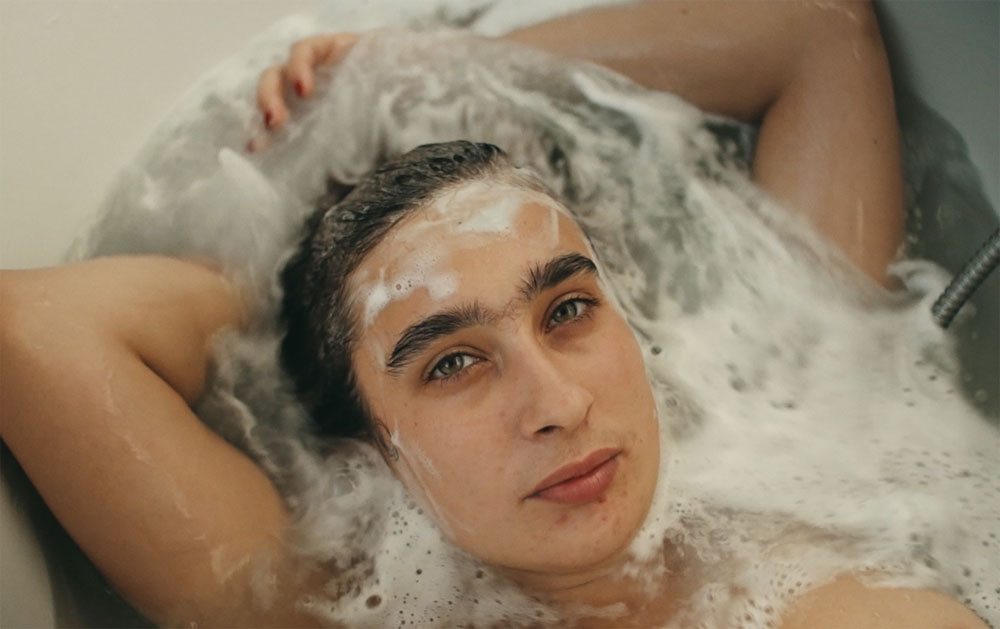For 13 years, Lea Glob had a life that was hidden away from most of the people who would say they knew her the best. It wasn’t a secret, but when you work on a professional project for that long, it becomes hard to describe and while she’d venture away from her native Denmark to check in on her globe-trotting subject Apolonia Sokol, an artist whose travels took her from Paris to Los Angeles and back again, friends and relatives would start to accept it without asking too many questions, though there were plenty to answer for when her worlds finally collided.
“Actually, at my wedding, I invited Apolonia and she heard someone say at the wedding party, “Yeah, so what is Lea doing again? She’s been following] a strange French person forever, you know, she’s never going to finish this film,” laughs Glob now. “And Apolonia was there with her glass of bubbly saying, ‘Oh, yes, I’m this person. Who are you?’ It’s a joy that people see there was a reason that we needed to do this film.”
Glob surely didn’t know she’d spend quite as much time filming Sokol as she ultimately did, but you can understand instantly why she couldn’t stop herself, parlaying what had initially been a class assignment to do a documentary profile in film school into the feature “Apolonia Apolonia” that was recently shortlisted for Best Documentary at the Oscars. Sokol was both an irresistible subject, teeming with restless creativity and a passion for life that she’d channel into her paintings, and a ready one, having parents from the theater who had documented her life from the time she was actually conceived. “Apolonia Apolonia” is remarkable for not missing a moment in her matriculation, but more so for what Glob is able to draw out in wisdom from being able to look at Sokol’s life so fully, comparing her own path to striking a balance between personal and professional pursuits and the lonely path that any artist takes to finding their distinctive voice.
As Sokol works out her frustrations in front of the camera propelling a rise in the art world where it’s remarkably hard to break through, “Apolonia Apolonia” comes across as a gem when it feels like Glob endured the same pressures in finding her way to tell her story, moving back and forth across time not to mention continents and untangle the complicated relationships that Sokol has with both her parents, whose divorce leaves her as the custodian of a ragtag theater company, and Oksana, a tempestuous Ukrainian activist who finds comfort with her that she can’t locate anywhere else in her life. It becomes clear that it wasn’t only the time the filmmaker put into filming Sokol, but the skills she accrued along the way that make the film resonate as it does as the film becomes a dual biography of both her life and Sokol’s and as the film begins to make its way out into the world, starting a theatrical run this week at the DCTV Firehouse in New York before expanding across the country via Grasshopper Film and Documentary+, the director reflected on what made her invest so much of herself into creating such a one-of-a-kind film, learning of all the footage that had been shot of Sokol before they met and what it was like to ultimately show her the chronicle of such a formative period in both their lives.
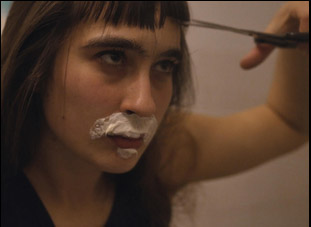
It was a blessing and a curse, however you see it, because I met the most extraordinary woman right in the beginning of my career when I was a student, not even a real trained film professional, so what can you do? I finished the short film, and it was a nice short, but it was not matching this larger-than-life character of Apolonia and her world. At the same time, it was also super addictive to me as a young woman to actually see another young woman very close to my own life, [working through] my own questions about everything on screen. When I was growing up, I didn’t see that many women that were interesting characters in film. It was a more stereotypical portrayal, but when I saw Apolonia, I realized that here I was with this young woman in my day and age where women have reached certain privileges in society, if you look at it in a historical way, and digital equipment was fairly cheap, so there was this possibility to follow a young, unknown, talented artist trying to make it as an artist in our day and age. [At the same time], it’s almost like a mythical story that humanity has always had and always will, so I thought that there was too much to miss out on and it really kept me.
I’m so glad that it did. And when you’re seeing Apolonia work things out in terms of what’s important for her as an artist, was there anything that crystallized for you as being important to capture?
I realized at some point that what Apolonia and I went through in both our businesses were kind of the same, so whenever I felt something she had to deal with, like trying to get accepted by your own guild [I thought] this is also where I am at, trying to just be able to make this film. I had to pass through so many stages and these gatekeepers for a film to come about [when] it’s not entirely low budget, [while] at the same time trying to create a space for yourself in the world as a human being in these very formative years. So many crazy mirrors were there when I was filming, and even some of the scenes in the film, I was literally filming her face and she’s painting from a mirror, doing a self-portrait, so it’s like we are both trying to interpret this person. She’s trying to interpret herself and I’m one step further back, so all of these things were there a lot of the time.
At one point I had this feeling that didn’t make it into the film, but some of the first things I wrote [as part of] the narration was that this is so strange. I just feel so much at home here because it was with Apolonia and with Oksana. They were painting in the theater and it was summertime and I had this smell of turpentine and the noises from a painting, like fingers on a canvas and time standing still. And then I remembered at that moment, “Okay, why am I here?” [And I thought back to how] as a young child, I was with my grandparents a lot, and [my grandfather] was a painter and he told me stories about painters. I always looked at this whole world of trying to get recognition and where do you stand and what makes life worth living. So many of those things fell into that, and of course, while making a film where you’re in this process where you don’t really know where things are going, when I had to finalize the film and we were both grown women, [we] could put into words more what was the work that we did about and where did we meet on the issues of femininity and the body and stuff like that.
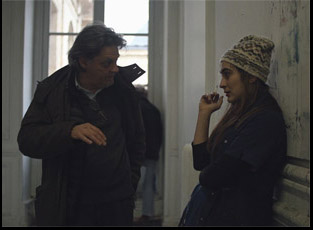
Filming for such a long time had some limitations. Apolonia actually managed to move herself from one social position in society to another, and for any person to do that in a lifetime is a very big achievement. It doesn’t happen very often and many people were really interested in showing a part of this world to us, the world of the artists, so that helped, but from the filmmaking perspective, we had holes in the story because I couldn’t be there all the time. And I never found a way to photograph this bloody theater that matched how wonderful and incredible it was because I’d never been anywhere quite like it and I miss it so much — this place where everything is possible and the people who run the place see that the reason for them to exist is to help artists create. This is really what Apolonia was born into. How many [people] tell you that in your everyday life, like, “Oh, welcome, you’re an artist,” and just be open to that?
So this theater was this wonderful place that I really needed [in the film], and [I could feel] this yearning for personal expression and artistic freedom, but it was not in the image. It’s just, “Okay, but this is a wall,” so how does this wall in my image really convey to the audience that this magic of the theater?” No matter how much I shot, it just looked like a trashy building. So I had to build a model, both so you could understand the structure of it, but also in a way when you create stuff, you add layers of meaning to it. I was also inspired by Apolonia herself and her work [creating these] layers [in her own art]. And then I also love theater [as a form because] you just pretend that you have stuff, and if you don’t have it, everybody [accepts] the convention that, “Oh, that’s a flower,” and nobody cares that it’s not a flower [in reality].
This is really liberating for cinema to use the same freedom, and I was educated at a time where I was very influenced by the Dogme movement in the ’90s in Denmark, and the National Film School of Denmark, where I was educated, very much based their pedagogy [around] creating restrictions for yourself and knowing that [you’re creating something for] a theater, that there’s always an audience, and they know they’re watching a film, so why not play on that? My work with Susanne Eeg [our art director] really came into that, and she’s, an architect, but I met her at a film crash course and I love her way of working with scenography. We [asked ourselves], what are the defining homes for Apolonia in terms of the film? And it’s a very big question when you do a film when the audience is always thinking, “Where are we?” You have to use a lot of time [to set that up], and in fiction, of course, you can always write your character walking by a sign, but in documentary, it’s so different. So [creating this theater] solved a lot of those issues and gave it a feeling of structure to respect the audience’s need [to know] where are we and how long is it going to take us? The models did all of that very well.
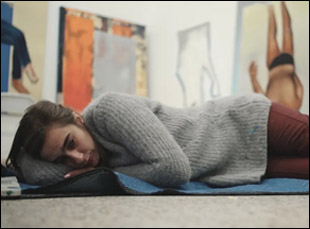
As you see in the film, Apolonia is always finding new incredible stuff around her that has the craziest history. I heard about this recording [of her conception], but it took a long time before Apolonia showed it to me, and then also to decide to share it with me in the film. Of course, when I saw it, I knew that, “Okay, this is cinema history because I never saw that on screen ever before.” And I’ve seen a lot and this was so beautiful to me and [her parents] were so cute. I was happy that she decided that it should go in there because, [this video] also has been always like a trauma for her because she didn’t really ask for this birthday gift of hers. But it found a good home in the film, she thought [as well as] her parents. And her mother and father were like young filmmakers, and it’s a film in their own right. You could do a whole film just of these old archives from the theater and I would love to see that film — I think that Apolonia’s father and mother should make it.
I hope so. I wouldn’t want to put that burden on you after spending all this time with it.
If they assign it to me, I will consider it. Let’s see.
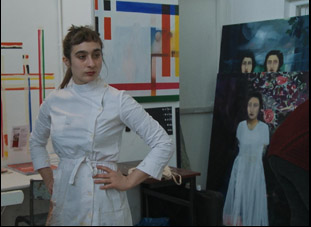
I showed her some small parts during the way, just so we had something to talk about. But the very first assembly of the film was very nerve-wracking because you spend so much time and promise so many things during the way, and it’s like, can I live up to all that and what will be her reaction? That’s scary. Would she be disappointed? But because she’s a painter, she also knows about this — it’s uncovering yourself and [exploring] how do you see another person? And I wouldn’t say that she didn’t like it, but there were some things that were very important for her [that weren’t in the initial assembly] and it was important for me that we could have time to incorporate that, so I really need to look at her perspective on it also.
But that’s beautiful in documentary filmmaking — if you do a shorter project, it could be more easy [to say to your subject], “Can you accept that this is going to be totally my vision and I’m going to frame it more exactly how I want.” But if you have such a long time, it needs so much more care. I remember when I was about to show her something, and a [fellow] filmmaker was at this screening facility, and he told me, “It’s the worst,” screening the film [for the subject] and, [worrying] will she like it? And luckily she did. But luckily she also made it even better by adding her perspective on things that I had been missing, and I was very happy for that. It was super hard to be able to listen because it was 13 years since I shot the first image, and people wanted a film now, so I had to wrap it up. But it was very good. I chose to do a film with Apolonia because she questions her surroundings all the time and that can be very demanding. But it’s also very, very interesting and necessary and I really learned so much more about the world through my time with her, and I really wanted other people to [have] that also.
“Apolonia Apolonia” will open on January 12th in New York at the DCTV Firehouse.




